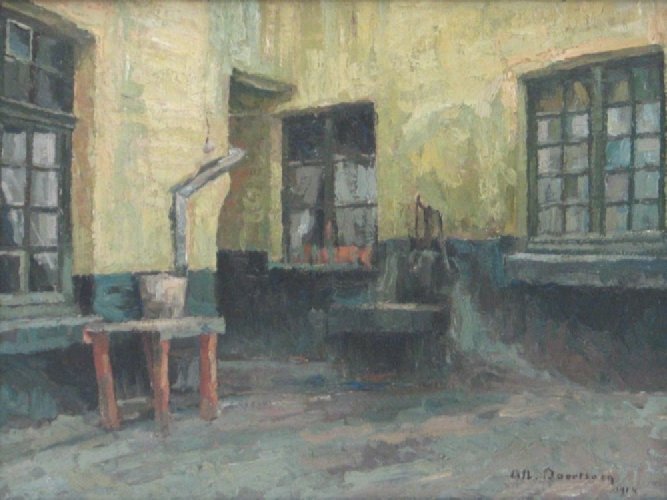Description:
Albert Baertsoen (1866-1922) was a Belgian painter and printmaker. He was a student of L. Tytgats and Is. Meyers, but his art was most influenced by J. Delvin, director of the Academy in Ghent. Baertson was called by critics the painter of dead cities, as his compositions were often deserted. His paintings were often a small fragment of city streets, alleys or canals, painted with muted colors, which gave a specific atmosphere to the painted places. The city he painted most often was Ghent, where he was born and where he lived for most of his life.
Description of the painting:
In a small, dark alleyway with yellowish walls stands a table with slightly crooked legs, with a bucket to which a zigzag pipe is connected. The composition also includes three dark and unfriendly windows. In the background of the image, a narrow, dark passage intrigues and also worries, as it does not reveal where it leads. The dark, marine–toned paint at the bottom of the walls almost merges with the dirty, gray–greenish ground. Against this background, between the windows, stands an unidentified object, possibly a well or another table.
The composition painted with muted, dirty and unexpected colors shows a small, uninteresting section of the city. The artist, with sincerity but also great sensitivity, observes some random, insignificant place, a corner of a poor district, where abandoned equipment is slowly disappearing into the darkness. Perhaps he was attracted here and encouraged to paint the saturated yellows of the walls, which, although slightly brighten the gloomy corner, create an intriguing color scheme. The use of a thickly applied layer of paint gives the abandoned place a feeling of light vibration or tremor. As if the corner were living its own mysterious life.
Baertson was called by critics a painter of dead cities, because his compositions were often unpopulated. His pictures were often a small piece of urban streets, alleys or canals, painted with muted colors, conveying the specific atmosphere of the places painted. The city he painted most willingly was Ghent, where he was born. He spent most of his life in its vicinity, so most likely the image of “Corner” is a frame from this city.


